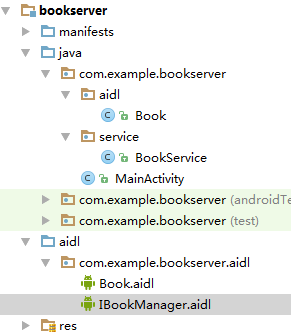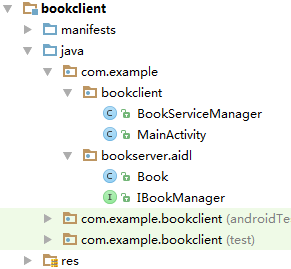Android AIDL实现两个APP间的跨进程通信实例
作者:袖梨
2022-06-25
本文为大家分享了Android AIDL实现两个APP间的跨进程通信实例,供大家参考,具体内容如下
1 Service端创建
首先需要创建一个Android工程然后创建AIDL文件,创建AIDL文件主要为了生成继承了Binder的Stub类,以便应用Binder进行进程间通信
servier端结构如下
AIDL代码如下
// IBookManager.aidl
package com.example.bookserver.aidl;
// Declare any non-default types here with import statements
import com.example.bookserver.aidl.Book;
interface IBookManager {
/**
* Demonstrates some basic types that you can use as parameters
* and return values in AIDL.
*/
void basicTypes(int anInt, long aLong, boolean aBoolean, float aFloat,
double aDouble, String aString);
List getBook();
boolean addBook(in Book book);
}
package com.example.bookserver.aidl; parcelable Book;
之后创建一个实现了Parcelable的Book.java类用来传递数据
package com.example.bookserver.aidl;
import android.os.Parcel;
import android.os.Parcelable;
/**
* Created by SAMSUNG on 2016-09-07.
*/
public class Book implements Parcelable {
private int id;
private String name ;
public int getId() {
return id;
}
public void setId(int id) {
this.id = id;
}
public String getName() {
return name;
}
public void setName(String name) {
this.name = name;
}
@Override
public String toString() {
return "Book{" +
"id=" + id +
", name='" + name + ''' +
'}';
}
@Override
public int describeContents() {
return 0;
}
@Override
public void writeToParcel(Parcel dest, int flags) {
dest.writeInt(this.id);
dest.writeString(this.name);
}
public Book() {
}
protected Book(Parcel in) {
this.id = in.readInt();
this.name = in.readString();
}
public static final Parcelable.Creator CREATOR = new Parcelable.Creator() {
@Override
public Book createFromParcel(Parcel source) {
return new Book(source);
}
@Override
public Book[] newArray(int size) {
return new Book[size];
}
};
}
最后我们来写一个Service用于客户端绑定
package com.example.bookserver.service;
import android.app.Service;
import android.content.Intent;
import android.os.Binder;
import android.os.IBinder;
import android.os.RemoteException;
import com.example.bookserver.aidl.Book;
import com.example.bookserver.aidl.IBookManager;
import java.util.List;
import java.util.concurrent.CopyOnWriteArrayList;
public class BookService extends Service {
private CopyOnWriteArrayList boookList = new CopyOnWriteArrayList();
public BookService() {
}
Binder binder = new IBookManager.Stub(){
@Override
public void basicTypes(int anInt, long aLong, boolean aBoolean, float aFloat, double aDouble, String aString) throws RemoteException {
}
@Override
public List getBook() throws RemoteException {
return boookList;
}
@Override
public boolean addBook(Book book) throws RemoteException {
return boookList.add(book);
}
};
@Override
public IBinder onBind(Intent intent) {
return binder;
}
@Override
public void onCreate() {
super.onCreate();
Book book = new Book();
book.setId(12345);
book.setName("Book 1");
boookList.add(book);
}
}
这样Server端就搞定了,接下来就该进行Client端的代码编写了
2 Client端
如下
首先我们要讲AndroidStudio 通过AIDL生成的Binder导入到Client中并将Book.java也导入到Client中
然后写进行Service的绑定
package com.example.bookclient;
import android.app.Service;
import android.content.ComponentName;
import android.content.Context;
import android.content.Intent;
import android.content.ServiceConnection;
import android.content.pm.PackageManager;
import android.content.pm.ResolveInfo;
import android.os.IBinder;
import android.util.Log;
import com.example.bookserver.aidl.IBookManager;
import java.util.List;
/**
* Created by SAMSUNG on 2016-09-07.
*/
public class BookServiceManager {
Context mContext = null;
IBookManager mService = null;
private static BookServiceManager bsm ;
public static BookServiceManager getInstance(Context context){
if(bsm==null){
bsm = new BookServiceManager(context);
}
return bsm;
}
public IBookManager getBookServie(){
while (mService==null){
Log.d("BookServiceManager", "getBookServie: ");
this.connectService();
}
return mService;
}
public BookServiceManager(Context mContext) {
this.mContext = mContext;
}
ServiceConnection scc = new ServiceConnection() {
@Override
public void onServiceConnected(ComponentName name, IBinder service) {
Log.d("BookServiceManager", "getBookServie: 2 ==> Bind ");
mService = IBookManager.Stub.asInterface(service);
}
@Override
public void onServiceDisconnected(ComponentName name) {
mService = null;
}
};
public boolean connectService(){
if(mService == null){
Log.d("BookServiceManager", "getBookServie: 2");
Intent intent = new Intent("com.example.bookserver.service.BookService");
final Intent eintent = new Intent(createExplicitFromImplicitIntent(mContext,intent));
mContext.bindService(eintent,scc, Service.BIND_AUTO_CREATE);
}
return true;
}
public static Intent createExplicitFromImplicitIntent(Context context, Intent implicitIntent) {
// Retrieve all services that can match the given intent
PackageManager pm = context.getPackageManager();
List resolveInfo = pm.queryIntentServices(implicitIntent, 0);
// Make sure only one match was found
if (resolveInfo == null || resolveInfo.size() != 1) {
return null;
}
// Get component info and create ComponentName
ResolveInfo serviceInfo = resolveInfo.get(0);
String packageName = serviceInfo.serviceInfo.packageName;
String className = serviceInfo.serviceInfo.name;
ComponentName component = new ComponentName(packageName, className);
// Create a new intent. Use the old one for extras and such reuse
Intent explicitIntent = new Intent(implicitIntent);
// Set the component to be explicit
explicitIntent.setComponent(component);
return explicitIntent;
}
}
最后对设置Button进行调用
package com.example.bookclient;
import android.os.Bundle;
import android.os.RemoteException;
import android.support.v7.app.AppCompatActivity;
import android.util.Log;
import android.view.View;
import android.widget.Button;
import com.example.bookserver.aidl.Book;
import com.example.bookserver.aidl.IBookManager;
public class MainActivity extends AppCompatActivity {
IBookManager mBookService ;
@Override
protected void onCreate(Bundle savedInstanceState) {
super.onCreate(savedInstanceState);
setContentView(R.layout.activity_main);
Button button = (Button) findViewById(R.id.button);
Button addButton = (Button) findViewById(R.id.button3);
Button findButton = (Button) findViewById(R.id.button2);
BookServiceManager.getInstance(getApplication()).connectService();
button.setOnClickListener(new View.OnClickListener(){
@Override
public void onClick(View v) {
mBookService = BookServiceManager.getInstance(getApplication()).getBookServie();
}
});
addButton.setOnClickListener(new View.OnClickListener(){
@Override
public void onClick(View v) {
Book book = new Book();
book.setId(2345);
book.setName("add book!!");
try {
mBookService.addBook(book);
} catch (RemoteException e) {
e.printStackTrace();
}
}
});
findButton.setOnClickListener(new View.OnClickListener(){
@Override
public void onClick(View v) {
try {
Log.d("MainActivity", mBookService.getBook().toString());
} catch (RemoteException e) {
e.printStackTrace();
}
}
});
}
}
这样我们就实现了AIDL的不同APP的调用。
相关文章
精彩推荐
-
 下载
下载孢子2生物进化中文版(Spores)
模拟经营 孢子2生物进化中文版(Spores)孢子2生物进化中文版让我们来做一回疯狂的博士,打造一个属于自
-
 下载
下载叫我万岁爷九游官方版
模拟经营 叫我万岁爷九游官方版叫我万岁爷带你体验当换地点感觉,全新的模拟手游大作让你开始一
-
 下载
下载梦回凤歌
模拟经营 梦回凤歌梦回凤歌手游中你将步入古代的宫廷纷争之中,本想度过美好幸福的
-
 下载
下载洋果子店rose最新版本
模拟经营 洋果子店rose最新版本洋果子店最新版是一款十分容易让人垂涎的开店经营类手游。游戏玩
-
 下载
下载明日大亨最新版
模拟经营 明日大亨最新版明日大亨手游,一个非常经典有趣的模拟经营类型的商战手游,在游

















